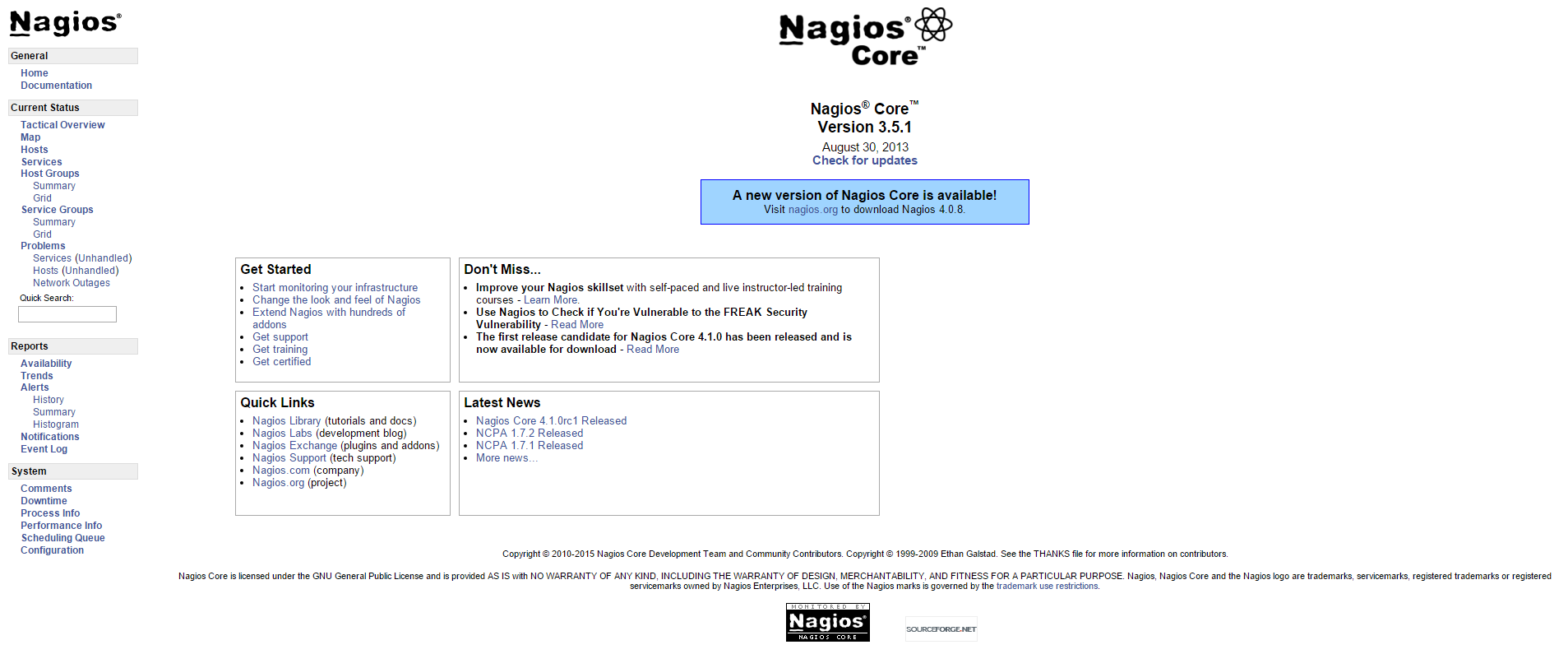 Краткая статья, без особых подробностей.
Краткая статья, без особых подробностей.
Установка выполняется на CentOS 7.
Вместо Apache HTTP — будет использоваться NGINX.
Содержание
Установка Nagios
Важно: у Nagios 3.5 есть проблемы при работе с NGINX. Поэтому — будем устанавливать 4.
Находим тут>>> последнюю версию (на момент написания — это была 4.1), качаем:
# cd /tmp/ # wget http://downloads.sourceforge.net/project/nagios/nagios-4.x/nagios-4.1.0/nagios-4.1.0rc1.tar.gz # tar xfp nagios-4.1.0rc1.tar.gz
Создаём пользователя и группу:
# useradd nagios
Собираем и устанавливаем Nagios:
# cd nagios-4.1.0rc1 # ./configure
# make all # make install # make install-init # make install-config # make install-commandmode # make install-webconf
Проверяем файл конфигурации:
# /usr/local/nagios/bin/nagios -v /usr/local/nagios/etc/nagios.cfg ... Total Warnings: 0 Total Errors: 0 Things look okay - No serious problems were detected during the pre-flight check
Nagios будет установлен в /usr/local/nagios:
# ls -l /usr/local/nagios/ total 12 drwxrwxr-x 2 nagios nagios 36 Jul 2 07:57 bin drwxrwxr-x 3 nagios nagios 70 Jul 2 07:57 etc drwxrwxr-x 2 nagios nagios 6 Jul 2 07:57 libexec drwxrwxr-x 2 nagios nagios 4096 Jul 2 07:57 sbin drwxrwxr-x 14 nagios nagios 4096 Jul 2 07:57 share drwxrwxr-x 5 nagios nagios 4096 Jul 2 08:04 var
Устанавливаем репозиторий Epel и плагины Nagios:
# yum install nagios-plugins-all
Подключаем плагины:
# rm -rf /usr/local/nagios/libexec # ln -s /usr/lib64/nagios/plugins /usr/local/nagios/libexec # chown -R nagios:nagios /usr/local/nagios/libexec
Запускаем Nagios:
# systemctl start nagios # systemctl status nagios nagios.service - SYSV: Starts and stops the Nagios monitor Loaded: loaded (/etc/rc.d/init.d/nagios) Active: active (running) since Wed 2015-07-01 09:45:00 UTC; 4s ago
Добавляем в автозапуск:
# chkconfig --add nagios
Создаём пользователя и пароль для HTTP-авторизации:
# htpasswd -c /usr/local/nagios/passwd nagiosadmin New password: Re-type new password: Adding password for user nagiosadmin
Создаём симлинки:
# mkdir /usr/local/nagios/share/nagios # cd /usr/local/nagios/share/nagios/ # ln -s /usr/local/nagios/share/stylesheets/ stylesheets # ln -s /usr/local/nagios/share/js js
# ls -l total 0 lrwxrwxrwx 1 root root 26 Jul 2 09:04 js -> /usr/local/nagios/share/js lrwxrwxrwx 1 root root 36 Jul 2 09:01 stylesheets -> /usr/local/nagios/share/stylesheets/
Установка NGINX и PHP-FPM
Устанавливаем NGINX, PHP и прочее:
# yum install nginx php php-fpm php-common gcc glibc glibc-common gd gd-devel make net-snmp
Проверяем статус старого Apache HTTP:
# systemctl status httpd Redirecting to /bin/systemctl status httpd.service httpd.service - The Apache HTTP Server Loaded: loaded (/usr/lib/systemd/system/httpd.service; disabled) Active: inactive (dead)
Если запущен — останавливаем и удаляем из автозагрузки:
# systemctl stop httpd.service
# systemctl disable httpd.service
НЕ удаляйте его, т.к. он зависимостями удалит и PHP.
Запускаем NGINX:
# systemctl start nginx.service
# systemctl status nginx.service nginx.service - The nginx HTTP and reverse proxy server Loaded: loaded (/usr/lib/systemd/system/nginx.service; disabled) Active: active (running) since Tue 2015-06-30 14:48:50 UTC; 2s ago ...
Проверяем:
# systemctl list-unit-files -t service | grep nginx nginx.service enabled
Добавляем в автозапуск:
# systemctl enable nginx.service
Готово:
Добавляем пользователя nginx в группу nagios:
# usermod -G nagios nginx
Создаём файл настроек PHP для Nagios — /etc/php-fpm.d/nagios.conf:
[nagios] ;listen = 127.0.0.1:9000 listen = /var/run/php-fpm/nagios.socket listen.allowed_clients = 127.0.0.1 ;listen.owner = nagios ;listen.group = nagios ;listen.mode = 0666 user = nagios group = nagios pm = dynamic pm.max_children = 50 pm.start_servers = 5 pm.min_spare_servers = 5 pm.max_spare_servers = 35 ;request_slowlog_timeout = 0 slowlog = /var/log/php-fpm/www-slow.log ;php_admin_value[sendmail_path] = /usr/sbin/sendmail -t -i -f [email protected] php_flag[display_errors] = on php_admin_value[error_log] = /var/log/php-fpm/nagios-error.log php_admin_flag[log_errors] = on ;php_admin_value[memory_limit] = 128M php_value[session.save_handler] = files php_value[session.save_path] = /var/lib/php/session
Запускаем и проверяем PHP-FPM:
# systemctl start php-fpm
# file /var/run/php-fpm/nagios.socket /var/run/php-fpm/nagios.socket: socket
# systemctl status php-fpm php-fpm.service - The PHP FastCGI Process Manager Loaded: loaded (/usr/lib/systemd/system/php-fpm.service; enabled) Active: active (running) since Wed 2015-07-01 09:44:00 UTC; 17s ago
# systemctl enable php-fpm.service ln -s '/usr/lib/systemd/system/php-fpm.service' '/etc/systemd/system/multi-user.target.wants/php-fpm.service'
Устанавливаем fcgiwrap.
# yum groupinstall 'Development Tools'
# yum install fcgi-devel spawn-fcgi
Загружаем и собираем его:
# cd /usr/local/src/ # git clone git://github.com/gnosek/fcgiwrap.git Cloning into 'fcgiwrap'... remote: Counting objects: 270, done. remote: Total 270 (delta 0), reused 0 (delta 0), pack-reused 270 Receiving objects: 100% (270/270), 62.89 KiB | 0 bytes/s, done. Resolving deltas: 100% (139/139), done. # cd fcgiwrap # autoreconf -i # ./configure # make cc -std=gnu99 -Wall -Wextra -Werror -pedantic -O2 -g3 fcgiwrap.c -lfcgi -o fcgiwrap # make install install -d -m 755 /usr/local/sbin install -m 755 fcgiwrap /usr/local/sbin install -d -m 755 /usr/local/man/man8 install -m 644 fcgiwrap.8 /usr/local/man/man8
Проверяем — появился ли файл:
# file /usr/local/sbin/fcgiwrap /usr/local/sbin/fcgiwrap: ELF 64-bit LSB executable, x86-64, version 1 (SYSV), dynamically linked (uses shared libs), for GNU/Linux 2.6.32, BuildID[sha1]=0x09dfb20974c770c2679722f7df7311f616711481, not stripped
Редактируем файл /etc/sysconfig/spawn-fcgi и приводим его к такому виду:
FCGI_SOCKET=/var/run/fcgiwrap.socket FCGI_PROGRAM=/usr/local/sbin/fcgiwrap FCGI_USER=nginx FCGI_GROUP=nginx FCGI_EXTRA_OPTIONS="-M 0700" OPTIONS="-u $FCGI_USER -g $FCGI_GROUP -s $FCGI_SOCKET -S $FCGI_EXTRA_OPTIONS -F 1 -P /var/run/spawn-fcgi.pid -- $FCGI_PROGRAM"
Запускаем его:
# systemctl start spawn-fcgi
Проверяем, что бы появился файл сокета:
# file /var/run/fcgiwrap.socket /var/run/fcgiwrap.socket: socket
Добавляем в автозапуск:
# chkconfig --add spawn-fcgi
Настройка NGINX
Создаём файл /etc/nginx/conf.d/nagios.conf:
server {
listen 80;
server_name 52.***.***.174;
access_log /var/log/nginx/nagios-access.log;
error_log /var/log/nginx/nagios-error.log info;
root /usr/local/nagios/share;
index index.php;
auth_basic "Nagios Restricted Access";
auth_basic_user_file /usr/local/nagios/passwd;
location /stylesheets {
alias /usr/local/nagios/share/stylesheets;
}
location ~ .cgi$ {
root /usr/local/nagios/sbin/;
include fastcgi_params;
rewrite ^/nagios/cgi-bin/(.*).cgi /$1.cgi break;
fastcgi_param AUTH_USER $remote_user;
fastcgi_param REMOTE_USER $remote_user;
fastcgi_pass unix:/var/run/fcgiwrap.socket;
fastcgi_param SCRIPT_FILENAME /usr/local/nagios/sbin/$fastcgi_script_name;
fastcgi_param PATH_INFO $fastcgi_script_name;
}
location ~ .php$ {
include fastcgi_params;
fastcgi_pass unix:/var/run/php-fpm/nagios.socket;
fastcgi_index index.php;
fastcgi_param SCRIPT_FILENAME /usr/local/nagios/share$fastcgi_script_name;
fastcgi_param PATH_INFO $fastcgi_script_name;
}
location ~ (.*.(ogg|ogv|svg|svgz|eot|otf|woff|mp4|ttf|rss|atom|jpg|jpeg|gif|png|ico|zip|tgz|gz|rar|bz2|doc|xls|exe|ppt|tar|mid|midi|wav|bmp|rtf))$ {
root /usr/local/nagios/share/;
rewrite ^/nagios/(.*) /$1 break;
access_log off; expires max;
}
}
Проверяем, и перезапускаем:
# nginx -t nginx: the configuration file /etc/nginx/nginx.conf syntax is ok nginx: configuration file /etc/nginx/nginx.conf test is successful
# systemctl restart nginx
# systemctl status nginx nginx.service - The nginx HTTP and reverse proxy server Loaded: loaded (/usr/lib/systemd/system/nginx.service; enabled) Active: active (running) since Wed 2015-07-01 10:35:24 UTC; 11s ago
Готово:
Ссылки по теме
http://www.tecmint.com
http://geekpeek.net
http://nightbook.info
http://rtfm.co.ua
http://rtfm.co.ua






